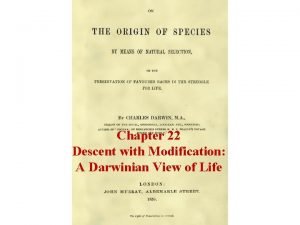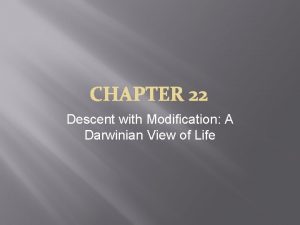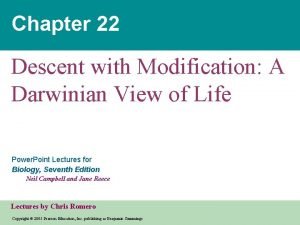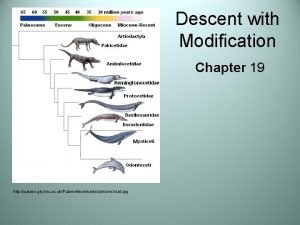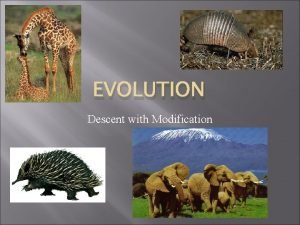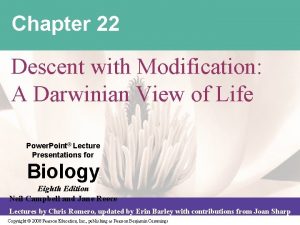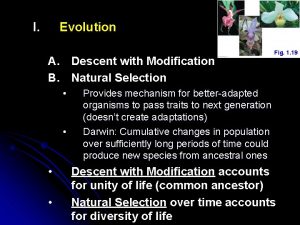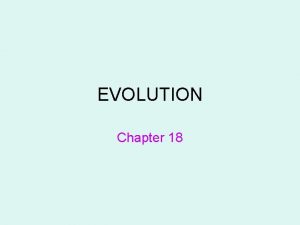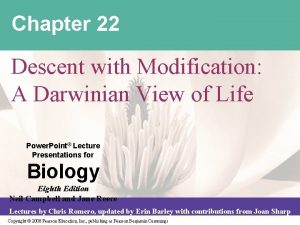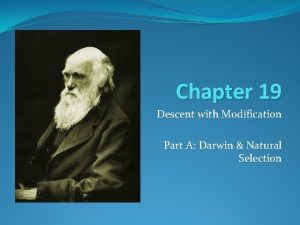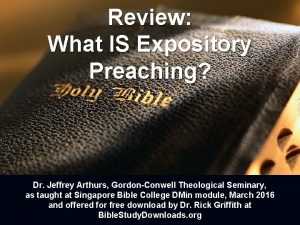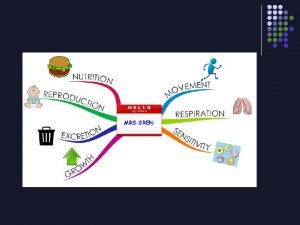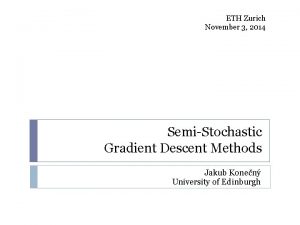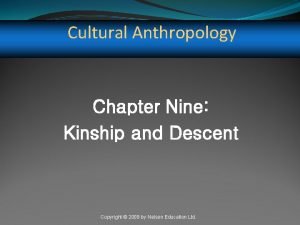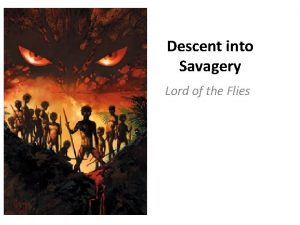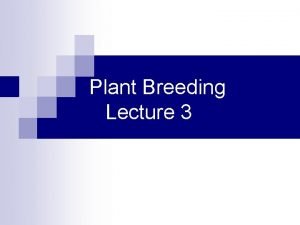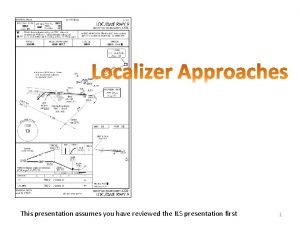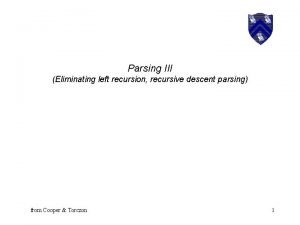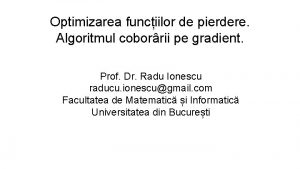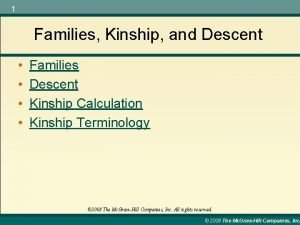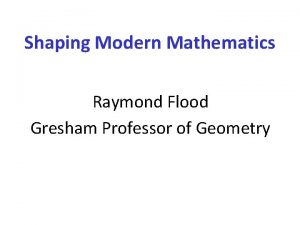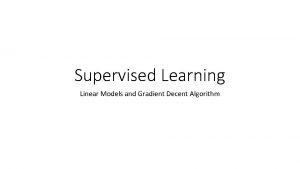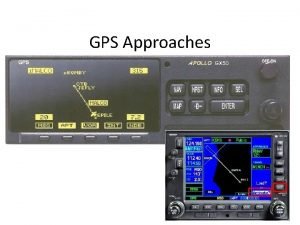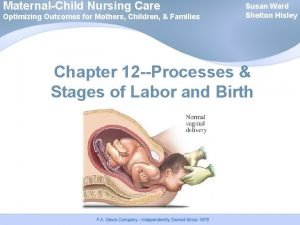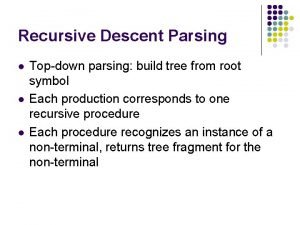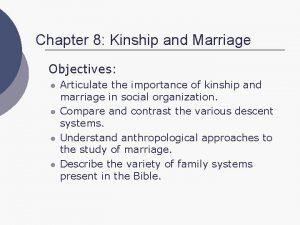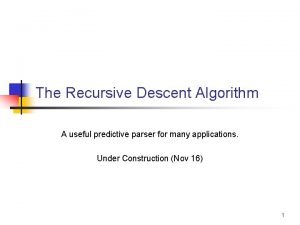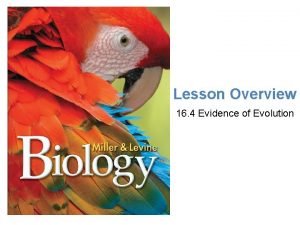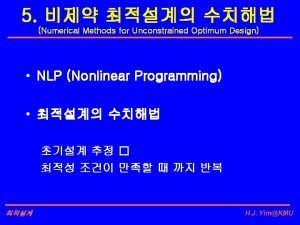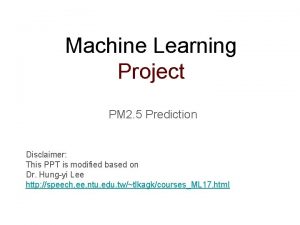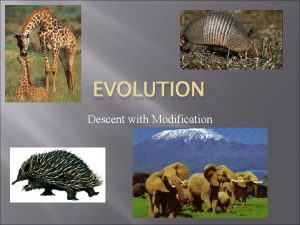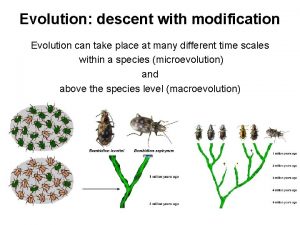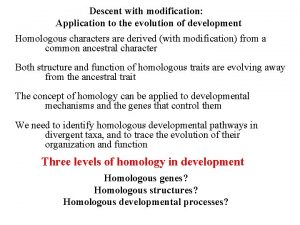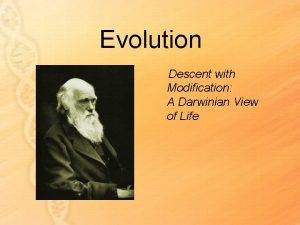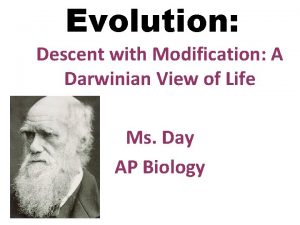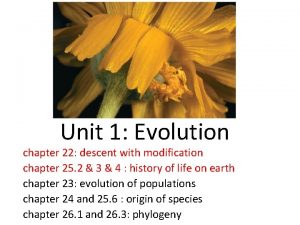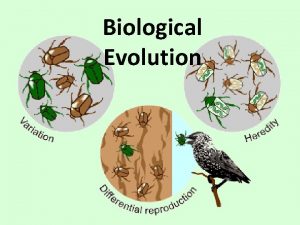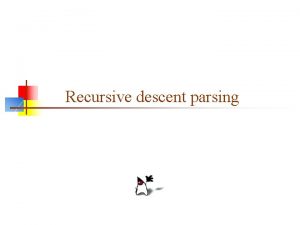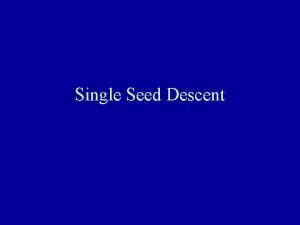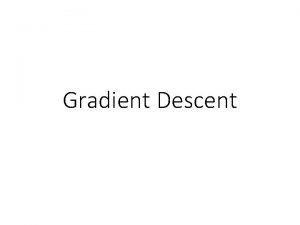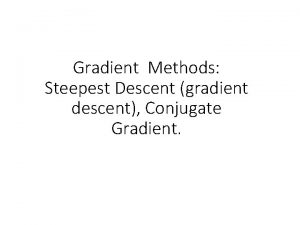Evolution Evolution is descent with modification the idea









































- Slides: 41

Evolution • Evolution is descent with modification; the idea that living species are descendents of ancestral species that were different from present-day ones • Evolution describes the genetic changes in a population over time

Evolution • Organisms are adapted to their environment; a good fit • As descendents of a remote ancestor spread into various habitats over millions and millions of years, they accumulate diverse modifications (adaptations) that fit them to specific ways of life • = descent with modification (evolution)

Evolution • Natural variation among individuals is based on heredity (and mutation). These variations enable organisms to become adapted to their environment over time

Natural Selection • Natural selection is the process by which favorable, inherited traits become more numerous in successive generations of a population of reproducing organisms • Over time, natural selection leads to species that are well adapted (highly evolved) to their environments

Natural Selection • Natural selection is the brain child of Charles Darwin; a naturalist who sailed around the world and noted the unique adaptations of animals in many diverse environments (most notably the Galapagos Islands)

The Principles of Natural Selection • Struggle for existence/Competition – More offspring are produced than can be supported by resources King Penguin Rookery © Momatiuk - Eastcott/Corbis

The Principles of Natural Selection • Variation – Some individuals, due to heredity or mutation, possess characteristics which make them better adapted to their environment

The Principles of Natural Selection • Inheritance of Traits – Best-suited organisms will survive to produce more individuals that share same adaptation

“Survival of the Fittest” • Organisms are adapted to their environment through natural selection • Natural selection is a pessimistic process

1 Population with varied inherited traits 2 Elimination of individuals with certain traits 3 Reproduction of survivors Certain individuals with a distinct, inherited characteristic will be selected against, while others with a (different) distinct, inherited trait will survive

Let’s look at an example… Normal allele; vulnerable to pesticides ‘Resistant’ allele passed to next generation Survivors Alternate allele; resistant to pesticides

Mechanisms of Evolution • Remember evolution is dependent on genetics! • Reproductive component – organisms must reproduce • Heredity component – offspring must resemble parents (traits passed on to offspring) • Variation component – there must be genetic variation among individuals of population • Genetic variation must lead to variation in fitness (the ability to survive and reproduce)

Evolution • Remember, evolution is the genetic change in populations over time • Individuals do NOT evolve; evolution refers to generation-to-generation changes • Evolution does not lead to perfectly-adapted organisms; natural selection results from environmental factors that vary from place to place and from time to time (a trait that is favorable in one situation may be detrimental in another)

Evolution • Evolution is a gradual change over time

Evidence for Evolution • Fossils!!! – the fossil record (the sequence in which fossils appear in layers of sedimentary rocks) provide some of the strongest evidence of evolution • Sedimentary rocks form from sand mud that settles to the bottom of seas, lakes and swamps; when organisms die, they settle along with the sediments and are preserved as fossils

Evidence for Evolution Seed fern: 150 mya Trilobite: 230 mya Allosaurus: 65 mya

Evidence for Evolution • Microevolution – evolution can be observed in nature (pesticide-resistance in insects, Peppered moths/industrial melanism) • A well-known example of microevolution is the case of the Peppered moths in England during the Industrial Revolution • Known as “industrial melanism”

Microevolution • Prior to the industrial revolution, light variants of the peppered moth survived better than dark variants because they blended well with the light colored trees (caused by the presence of a light-colored lichen) • Pre-industrial era – only light variant known • 1848 – first dark variant collected • Mid-1900’s – dark variant made up 90% of population in industrial areas!

Microevolution • Poor air quality killed the lichens which covered the otherwise dark trees and camouflaged the light moths against predation • Light moths were predated on; dark moths were not • (Prior to the industrial revolution, the reverse would be true)

Evidence for Evolution • Artificial selection – the process by which humans have modified other species by selectively breeding for desired traits • Darwin got the idea of natural selection from artificial selection! rds. yahoo. com/_ylt=A 0 WTef. U 0 ARNLry 4 Bea. jzbk. F/SIG=124 p 0 q bdv/EXP=1259623092/**http% rds. yahoo. com/_ylt=A 0 WTef. U WARNLn. T 8 Bgf. Wjzbk. F/SIG=12 ej enqc 8/EXP=1259623062/**htt p%3 A//www. flickr. com/photos

Terminal bud Cabbage Lateral buds Flower clusters Brussels sprouts Leaves Kale Cauliflower Stem Wild mustard Flowers and stems Broccoli Kohlrabi

Artificial Selection • All dogs are domesticated breeds of the Gray wolf, Canis lupus; “Fido” is actually a subspecies of the wolf!

Artificial Selection

Evidence for Evolution • Homologous structures – similar characteristics that result from a common ancestry Humerus Radius Ulna Carpals Metacarpals Phalanges Human Cat Whale Bat

Evidence for Evolution • A prime (and very amusing) example of homologous structures are vestigial organs; remnants of structures that have no apparent function, but served important functions in organism’s ancestors

Evidence for Evolution

Evidence for Evolution Vestigial structures of a whale http: //www. edwardtbabinski. us/mpm_whale_limb. html

Evidence for Evolution • In contrast to homologous structures, analogous structures also provide evidence for evolution • Analogous structures are structures that share similarities by a way of life, not by a common ancestry • Analogous structures arise among unrelated organisms in response to similar needs or similar environmental factors

Analogous structures Examples: wings of insects (a) and birds (b); flippers of seals (c) and penguins (d)

Evidence for Evolution • Remember, evolution uses the materials and processes that are already available (it fashions adaptations, rather than starting from scratch) • Evolution is a tinkerer, not a master engineer (a tinkerer uses tools already there to improve) • Adaptations are not perfect • Evolution is constant; traits that are welladapted for today may not be so tomorrow…

Evidence for Natural Selection • Darwin’s fishes of the Galapagos 14 species of finch; 1 common ancestor (from the mainland); different beaks

Anatomical Evidence of Evolution • • Orchid petals - used as pollinator lure Snake with 2 leg bones (vestigal) Manatee fingernails (vestigal) Humans – muscles for wiggling ears

Developmental similarities reflect descent from a common ancestor

Ontogeny recapitulates phylogeny! • • Pop quiz time!!! Which of the bottom images shows a lemur? A pig? A human?

Mutations and sexual reproduction are the driving forces of evolution • New alleles originate by mutation, a change in the nucleotide sequence of DNA • Only mutations in cells that produce gametes can be passed along to offspring • Most mutations are harmful, however a mutant allele may improve the adaptation of an individual to its environment and enhance its reproductive success

Mutations and sexual reproduction are the driving forces of evolution • Mutation rates in animals and plants average ~1 in every 100, 000 genes per generation (a slow process!) • Sexual reproduction is a quick and easy (insert giggling here) means of increasing genetic diversity and variation, creating geneticallydistinct individuals with new combinations of alleles (which may enhance adaptation and reproductive success!)

Evolution • Evolution is a widely accepted scientific theory that describes the observed changes in living things over time • Scientists use evolution to explain the great diversity of life, but some dispute its ability to describe the origins of life on Earth http: //www. bizofshowbiz. com/uploads/Geico%20 Cavemen. jpg

Other theories out there Name Descent with modification? Common ancestor? Extinction? Creation (A) No No No Transformism (B) Yes No No Evolution (C) Yes Yes extinction (A) change (B) change (C) change

FSM • And my personal favorite – The Church of the Flying Spaghetti Monster! • Satirical protest to Kansas Board of Education’s decision to require the teaching of Intelligent Design, an alternative to Creationism which avoids specifying identity of ‘designer’ • Founded in 2005 • The FSM is invisible and undetectable; evidence of evolution planted by FSM to test “Pastafarian”’s faith

FSM

Evolution • Remember, evolution is an accepted (and well -supported) scientific theory • Scientific theories can never be proven (you cannot prove a hypothesis) but can be supported or rejected; must also be testable and falsifiable • Distinct from religion, which is neither testable or falsifiable; nonetheless, debates over evolution linger on!
 Evolution descent with modification
Evolution descent with modification Chapter 22 descent with modification
Chapter 22 descent with modification Ch 22 descent with modification
Ch 22 descent with modification Survival for the fittest
Survival for the fittest Descent with modification: a darwinian view of life
Descent with modification: a darwinian view of life Ameoba
Ameoba Modification
Modification Chapter 22: descent with modification
Chapter 22: descent with modification Descent with modification definition
Descent with modification definition Ontogeny recapitulates phylogeny
Ontogeny recapitulates phylogeny What is descent with modification
What is descent with modification Chapter 19 descent with modification
Chapter 19 descent with modification Example of supporting sentence
Example of supporting sentence Whats the central idea
Whats the central idea Stated main idea and implied main idea
Stated main idea and implied main idea Expository preaching vs. exegetical preaching
Expository preaching vs. exegetical preaching Penanda organisasi
Penanda organisasi What is the difference between topic and theme
What is the difference between topic and theme Control idea
Control idea Big idea evolution
Big idea evolution Gradient descent rule
Gradient descent rule Stochastic gradient descent
Stochastic gradient descent Double descent anthropology
Double descent anthropology Descent into savagery
Descent into savagery Plant breeding
Plant breeding Visual descent point
Visual descent point Eliminating left recursion
Eliminating left recursion Batch gradient descent
Batch gradient descent Lineal kinship terminology
Lineal kinship terminology Professor raymond flood
Professor raymond flood Gradient descent equation
Gradient descent equation Lpv approach
Lpv approach The work done by gravity during the descent of a projectile
The work done by gravity during the descent of a projectile Fetal descent stations
Fetal descent stations Recursive descent parser
Recursive descent parser Nltk recursive descent parser
Nltk recursive descent parser Kinship definition
Kinship definition Bann hadi
Bann hadi Recursive descent parser calculator java
Recursive descent parser calculator java Common descent
Common descent Descent direction
Descent direction Linear regression gradient descent
Linear regression gradient descent

